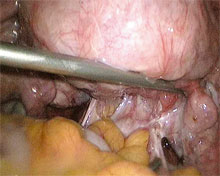Endometriosis is an enigmatic disease which affects up to 6-10% of women of reproductive age. It is present in 25-50% of women with infertility and pelvic pain. Recently an increase in its incidence has been noted in many countries. It is a major burden to its sufferers and to healthcare systems.
The characteristic feature of endometriosis is the presence of endometrial cells (cells that line the inner wall of the womb) in other sites. The pelvis is by far the commonest site for deposits of endometriosis but the disease has been described in distant sites such as the lungs and the eye. The other characteristic of the disease is the inflammation that occurs in relation to these tissues, which results in pain. Deposits also have nerve fibres that are responsible for the pain.
Despite extensive research, the exact cause of endometriosis remains unknown.
A vast body of evidence suggests a link with pollution. The probable link is via xenoestrogens, a word used to describe pollutants which have similar actions to oestrogens on the body. The list includes many pollutants, with heavy metals such as nickel and cadmium being added recently.
Deposits of endometriosis cause irritation of the peritoneum (the lining of the inside of the abdominal cavity) which results in tissues becoming pasted to one another. These are referred to as ‘adhesions’, which cause the structure of the pelvis to be distorted. This is the primary way endometriosis causes infertility. However, the disease could affect fertility by the mere presence of deposits, even without distorting the anatomy. Ovaries that are adherent to the lower reaches of the pelvis could cause pain during sexual intercourse. This effect could also arise due to the presence of deposits in the lower part of the pelvis.
Endometriosis could produce disabling pain. The cardinal features of the disease are infertility, pain during sexual intercourse and pain during menstruation. Typically, menstrual pain due to endometriosis outlasts the bleeding, meaning it begins before, lasts throughout and ends after the bleeding. Menstrual pain that begins afresh or keeps getting worse with time are also highly suggestive of the disease. Deposits in the ovaries bleed cyclically to produce collections of blood which result in what are commonly called ‘chocolate cysts’ (endometriomas) with the blood changing its colour to brown with time.
 |
| A picture taken at laparoscopy showing extensive adhesions due to endemetriosis |
The gold standard for diagnosing endometriosis is a laparoscopy. However, the presence of endometriomas and other signs will indicate the diagnosis on ultrasound scanning. This is done more accurately via the ‘transvaginal’ approach. Sophisticated instruments also enable the doctor to treat the condition at the time of performing laparoscopy for diagnosis.
It has the advantage of a minimally invasive approach with quicker recovery. It also gives a better approach to the lower reaches of the pelvis where the disease is more prevalent and also a way to magnify the area of operation, improving precision.
Not all endometriosis needs to be treated by surgery, however. Those who have lesser degrees of pain may benefit from simple analgesics. Pregnancy has long been recognized to have a positive effect on endometriosis, but one of the problems of the disease itself is difficulty in conceiving. The commonly used contraceptives, the ‘pill’ and Depo Provera injections are considered first-line treatments for the condition. Prolonged use of these mimics pregnancy and gives temporary relief.
There are other drugs also available for treatment, but the consensus among experts is that these do not confer additional advantages over the first-line drugs which are considerably cheaper. Taking the ‘pill’ in a way that brings on a withdrawal bleed once in three months will have particular advantages for women with menstrual pain. The newer hormone-releasing intrauterine devices are a useful addition since they suppress menses, thus reducing associated pain.
The main disadvantage of treating endometriosis with drugs is that they necessarily act against conception. Therefore, women with endometriosis-associated infertility will have to undergo surgery for relief. This will allow the normal structure of the pelvis to be restored by separating the adhesions. The deposits could also be destroyed by cauterizing them.
Another category of patients who will need surgery are those suffering pain during intercourse. Treatment with medicines is of little value to them. It is recommended that chocolate cysts of more than 3 cm diameter are treated surgically as well. Women who have failed to respond to treatment and continue to have disabling symptoms will require to be treated by removing the uterus and both ovaries. This will expose the sufferer to the effects of a premature menopause.
Endometriosis is a frustrating disease to have and to treat, since the disease has a tendency to recur despite treatment. Typically, its diagnosis is delayed since women accept pain during menses as a normal phenomenon. Late presentation makes its treatment a greater challenge.
|
